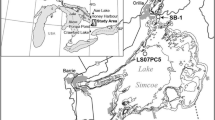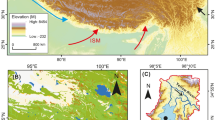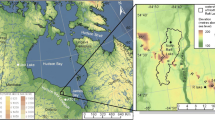Abstract
Pollen is ubiquitous in nearshore marine sediments; however, its potential importance for food-limited deep-seabed communities remains unknown. Here we report on the distribution of pollen to depths of 10,800 m in two Southwest Pacific trenches, as well as relationships between pollen concentrations and the sediment fauna. Pine (Pinus radiata) pollen, most likely originating from extensive plantations in New Zealand, was common in all sediment samples. These pine plantations may have altered the flux of terrestrially derived organic matter to vast stretches of the deep sea, with potential consequences for carbon sequestration and food availability. There was a significant, positive correlation between pine pollen and the abundance of infauna, which were greatest at the 7000-m-deep site in the Kermadec Trench and 10,800-m site in the Tonga Trench. This finding, together with the occurrence of pine pollen in unicellular organisms (gromiids), shows for the first time that pollen may represent food source for deep-sea benthic organisms.





Similar content being viewed by others
References
Anderson MJ, Gorley RN, Clarke KR. 2008. PERMANOVA + for PRIMER: guide to software and statistical methods. Plymouth: PRIMER-E.
Balance PF, Follas HA, Froggatt PC, Mikhailic EV. 2000. Continent-derived vitric mud and mafic-arc rocks in deep Kermadec Trench diamictons. J Sediment Res 70:140–50.
Belyaev GM. 1966. Bottom fauna of the ultra-abyssal depths of the world ocean. Akad Nauk SSSR, Trudy Inst Okeanol 103:259–80.
Belyaev GM. 1989. Deep-sea ocean trenches and their fauna. Moscow: Nauka Publishing House.
Berner RA. 1982. Burial of organic carbon and pyrite sulfur in the modern ocean: its geochemical and environmental significance. Am J Sci 282:451–73.
Bienhold C, Ristova PP, Wenzhöfer F, Dittmar T, Boetius A. 2013. How deep-sea wood falls sustain chemosynthetic life. PLoS ONE 8:e53590.
Blankenship LE, Levin LA. 2007. Extreme food webs: foraging strategies and diets of scavenging amphipods from the ocean’s deepest 5 kilometres. Limnol Oceanogr 52:1685–97.
Borrell JS. 2012. Rapid assessment protocol for pollen settling velocity: implications for habitat fragmentation. Biosci Horiz 5:1–9.
Bourgeois JC, Gajewski K, Koerner RM. 2001. Spatial patterns of pollen deposition in arctic snow. J Geophys Res 106(D6):5255–65.
Bruun AF. 1956. The abyssal fauna: its ecology, distribution and origin. Nature 177:1105–8.
Burdige DJ. 2005. Burial of terrestrial organic matter in marine sediments: a re-assessment. Global Biogeochem Cycles 19:4011.
Burdon RD. 2000. Pinus radiata. In: Last FT, Ed. Ecosystems of the world, vol. 19, Tree crops. Ch. 5. Amsterdam: Elsevier. p 99–161.
Campbell ID, McDonald K, Flannigan MDM, Kringayark J. 1999. Long-distance transport of pollen into the Arctic. Nature 399:29–30.
Carvalho FP, Oliveira JM, Soares AMM. 2011. Sediment accumulation and bioturbation rates in the deep Northeast Atlantic determined by radiometric techniques. ICES J Mar Sci 68:427–35.
Chiswell SM, Sutton PJH. 2015. Drifter- and float-derived mean circulation at the surface and 1000 m in the New Zealand region. NZ J Mar Freshwat Res 49:259–77.
Crouch EM, Mildenhall DC, Neil HL. 2010. Distribution of organic-walled marine and terrestrial palynomorphs in surface sediments, offshore eastern New Zealand. Mar Geol 270:235–56.
Czeczuga BE, Muszynska E. 2001. Zoosporic fungi growing on gymnosperm pollen in water of varied trophic state. Pol J Environ Stud 10:89–94.
Danovaro R, Gambi C, Della Groce N. 2002. Meiofauna hotspot in the Atacama Trench, eastern South Pacific Ocean. Deep-Sea Res I 49:843–57.
Davis MB. 1973. Redeposition of pollen grains in lake sediment. Limnol Oceanogr 18:44–52.
Davis RB. 1974. Stratigraphic effects of tubificids in profundal lake sediments. Limnol Oceanogr 19:466–88.
Doskey PV, Ugoagwu B. 1989. Atmospheric deposition of macronutrients by pollen at a semi-remote site in northern Wisconsin. Atmos Environ 23:2761–6.
Duarte CM, Middelburg JJ, Caraco N. 2005. Major role of marine vegetation in the oceanic carbon cycle. Biogeosciences 2:1–8.
Dunlop K, van Oevelen D, Ruhl HA, Huffard CL, Kuhnz LA, Smith KL Jr. 2016. Carbon cycling in the deep eastern North pacific benthic food web: investigating the effect of organic carbon input. Limnol Oceanogr 61:1956–68.
Dupont LM, Wyputta U. 2003. Reconstructing pathways of Aeolian pollen transport to the marine sediments along the coastline of SW Africa. Quat Sci Rev 22:157–74.
Feller RJ, Warwick RM. 1988. Energetics. In: Higgins RP, Thiel H, Eds. Introduction to the study of meiofauna. Washington: Smithsonian Institution Press. p 181–96.
Findlay S, Tenore K. 1982. Nitrogen source for a detritivore: detritus substrate versus associated microbes. Science 218:371–3.
Fountain DW, Cornford CA. 1991. Aerobiology and allergenicity of Pinus radiata pollen in New Zealand. Grana 30:71–5.
Greenfield LG. 1996. Plant pollen production in selected tree species. Canterb Bot Soc J 31:10–13.
Greenfield LG. 1999. Weight loss and release of mineral nitrogen from decomposing pollen. Soil Biol Biochem 31:353–61.
Grove SL, Probert PK, Berkenbusch K, Nodder SD. 2006. Distribution of bathyal meiofauna in the region of the Subtropical Front, Chatham Rise, south-west Pacific. J Exp Mar Biol Ecol 330:342–55.
Groot JJ, Groot CR. 1966. Pollen spectra from deep-sea sediments as indicators of climatic changes in southern South America. Mar Geol 4:525–37.
Hedges JI, Keil RG, Benner R. 1997. What happens to terrestrial organic matter in the ocean? Org Geochem 27:195–212.
Heusser L, Balsam WL. 1977. Pollen distribution in the Northeast Pacific Ocean. Quat Res 7:45–62.
Ichino MC, Clark MR, Drazen JC, Jamieson A, Jones DOB, Martin AP, Rowden AA, Shank TM, Yancey PH, Ruhl HA. 2015. The distribution of benthic biomass in hadal trenches: a modelling approach to investigate the effect of vertical and lateral organic matter transport to the seafloor. Deep-Sea Res I 100:21–33.
Jamieson AJ. 2015. Ecology of deep oceans: hadal trenches. Cambridge: Cambridge University Press. p 382.
Kagami M, Miki T, Takimoto G. 2014. Mycoloop: chytrids in aquatic food webs. Front Microbiol 5:166.
Keil RG, Hu FS, Tsamakis EC, Hedges JI. 1994. Pollen in marine sediments as an indicator of oxidation of organic matter. Nature 369:639–41.
Klimco M, Bykowska J. 2015. Pollen morphology of Pinus uliginosa Neum. and Pinus uncinata Ramond ex dc in an experimental culture. Steciana 19:153–61.
Kobayashi H, Hatada Y, Tsubouchi T, Nagahama T, Takami H. 2012. The hadal amphipod Hirondellea gigas possessing a unique cellulase for digesting wooden debris buried in the deepest seafloor. PLoS ONE 7:e42727.
Kulm LD, Roush RC, Harlett JC, Neudeck RH, Chambers DM, Runge EJ. 1975. Oregon continental shelf sedimentation: Interrelationships of facies distribution and sedimentary processes. J Geol 83:145–75.
Lavery PB, Mead DJ. 1998. Pinus radiata: a narrow endemic from North America takes on the world. In: Richardson DM, Ed. Ecology and biogeography of pinus. Cambridge: Cambridge University Press. p 432–49.
Leduc D, Rowden AA, Glud RN, Wenzhöfer F, Kitazato H, Clark MR. 2016. Comparison between infaunal communities of the deep floor and edge of the Tonga Trench: Possible effects of differences in organic matter supply. Deep-Sea Res I 116:264–75.
Lewis NB, Ferguson IS, Sutton WRJ, Donald DGM, Lisboa HB. 1993. Management of radiata pine. North Ryde: Inkata Press Pty Ltd/Butterworth-Heinemann. p 404.
Luo C, Jiang C, Yang M, Chen M, Xiang R, Zhang L, Liu J, Pan A. 2016. Transportation modes of pollen in surface waters in the South China Sea and their environmental significance. Rev Palaeobot Palynol 225:95–105.
Masclaux H, Perga ME, Kagamie M, Desvilettes C, Bourdier G, Bec A. 2013. How pollen organic matter enters freshwater food webs. Limnol Oceanogr 58:1185–95.
Meijboom FW, Hassink J, Van Noordwijk M. 1995. Density fractionation of soil macroorganic matter using silica suspensions. Soil Biol Biochem 27:1109–11.
Moens T, Vincx M. 1997. Observations on the feeding ecology of estuarine nematodes. J Mar Biol Assoc UK 77:211–27.
Mudie PJ, McCarthy FMG. 2006. Marine palynology: potentials for onshore-offshore correlation of Pleistocene-Holocene records. Trans R Soc S Afr 61:139–57.
Mudie PJ. 1982. Pollen distribution in recent marine sediments, eastern Canada. Can J Earth Sci 19:729–47.
Murashima T, Nakajoh H, Takami H, Yamauchi N, Miura A, Ishizuka T. 2009. 11,000 m class free fall mooring system. Proceedings of OCEANS 2009-EUROPE, 2009. pp 1–5.
Niklas KJ. 1985. The aerodynamics of wind pollination. Bot Rev 51:328–86.
Robbins EI, Cuomo MC, Haberyan KA, Mudie PJ, Chen YY, Head E. 1996. Fecal pellets. In: Jansonius J, McGregor DD, Eds. Palynology: Principles and Applications, Vol. 3. Irving: AASP Foundation. p 1085–97.
Romero OE, Dupont L, Wyputta U, Jahns S, Wefer G. 2003. Temporal variability of fluxes of eolian-transported freshwater diatoms, phytoliths, and pollen grains off Cape Blanc as reflection of land-atmosphere-ocean interactions in northwest Africa. J Geophys Res 108:3153.
Roulston TH, Cane JH. 2000. Pollen nutritional content and digestibility for animals. Plant Syst Evol 222:187–209.
Rowe G, Sibuet M, Deming J, Khripounoff A, Tietjen J, Macko S, Theroux R. 1991. Total sediment biomass and preliminary estimates of organic carbon residence time in deep-sea benthos. Mar Ecol Prog Ser 79:99–114.
Shirayama Y. 1984. Vertical distribution of meiobenthos in the sediment profile in bathyal, abyssal and hadal deep sea systems of the Western pacific. Oceanol Acta 7:123–9.
Smith KL, Ruhl HA, Bett BJ, Billett DSM, Lampitt RS, Kaufmann RS. 2009. Climate, carbon cycling, and deep-ocean ecosystems. PNAS 106:19211–18.
Somerfield PJ, Warwick RM. 1996. Meiofauna in marine pollution monitoring programmes: a laboratory manual. Lowestoft: Ministry of Agriculture, Fisheries and Food. p 71.
Stanley EA. 1969. Marine palynology. Annu Rev Oceanogr Mar Biol 7:277–92.
Todo Y, Kitazato H, Hashimoto J, Gooday AJ. 2005. Simple foraminifera flourish at the ocean’s deepest point. Science 4:689.
Traverse A, Ginsberg RN. 1966. Palynology of the surface sediments of Great Bahama Bank, as related to water movement and sedimentation. Mar Geol 4:417–59.
Vanreusel A, Vincx M, Schram D, van Gansbeke D. 1995. On the vertical distribution of th metazoan Meiofauna in shelf break and upper slope habitats of th NE Atlantic. Hydrobiology 80:313–26.
Webster EA, Tilston EL, Chudek JA, Hopkins DW. 2008. Decomposition in soil and chemical characteristics of pollen. Eur J Soil Sci 59:551–8.
Wenzhöfer F, Oguri K, Middelboe M, Turnewitsch R, Toyofuku T, Kitazato H. 2016. Benthic carbon mineralization in hadal trenches: assessment by in situ O2 microprofile measurements. Deep-Sea Res I 116:276–86.
Wolff T. 1979. Macrofaunal utilization of plant remains in the deep. Sarsia 64:117–36.
Zafiriou OC, Gagosian RB, Peltzer ET, Alford JB, Loder T. 1985. Air-to-sea fluxes of lipids at Enewetak Atoll. J Geophys Res 90:2409–23.
Acknowledgements
Funding for this project was provided by NIWA’s Coasts and Oceans Centre Research programme ‘Marine Biological Resources’, by the New Zealand Ministry of Business, Innovation and Employment (MBIE), and through NIWA’s research programme ‘Impact of resource use on vulnerable deep-sea communities’ (CO1X0906). We are grateful to Tim Shank (WHOI, USA), and the other principal investigators of the HADES project (HADal Ecosystem Studies, funded by the National Science Foundation, NSF-OCE 1130712, 1130494, and 1131620), to the officers, crew, and scientific personnel of RV Thomas G. Thompson (voyage TN309), and ROV Nereus engineers and technicians. We also thank Hiroshi Kitazato (JAMSTEC, Japan) the leader of the RV Yokosuka voyage YK13-10 and thank the officers, crew, and scientific personnel of that voyage. We are indebted to Matteo Ichino (National Oceanography Centre and University of Southampton, UK) for calculating and supplying the data for relative elevation at the study sites. We are very grateful to Scott Nodder (NIWA) for his support, Gustav Kessel for analysing pollen samples, Kevin Mackay (NIWA) for his help in preparing Figure 1, and Joe Prebble (Geological and Nuclear Sciences) for his advice. We are grateful to two anonymous reviewers for providing constructive criticisms on the manuscript.
Author information
Authors and Affiliations
Corresponding author
Additional information
Author Contributions
A.R. and D.L. devised the study and obtained the samples. D.L. processed the samples and led data analyses in collaboration with A.R. D.L. drafted the manuscript with critical and substantial contributions from A.R.
Electronic Supplementary Material
Below is the link to the electronic supplementary material.
Rights and permissions
About this article
Cite this article
Leduc, D., Rowden, A.A. Not to be Sneezed at: Does Pollen from Forests of Exotic Pine Affect Deep Oceanic Trench Ecosystems?. Ecosystems 21, 237–247 (2018). https://doi.org/10.1007/s10021-017-0146-8
Received:
Accepted:
Published:
Issue Date:
DOI: https://doi.org/10.1007/s10021-017-0146-8




